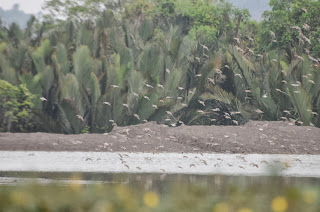Of course this was not a pleasure trip, and I dd not expect to get much time in the field (though I certainly didn't work as hard as Eileen, who was at her mother's bedside day and night). However, thanks to my friends Anthony Wong and Vincent Wong (not related), on August 5 I did have a chance to make a morning visit to the Sejingkat Ash Ponds, where Anthony is keeping track of migrating waders (shorebirds to us North Americans).
I would have thought that most waders would still be on their northern breeding grounds in early August, and that there would be little to see. I was, happily, wrong.
Swirling flocks of birds circled the ponds, where they feed on insect larvae and other invertebrates until falling tides uncover the sand islands out in Buntal Bay, where most of the birds spend the rest of their time.
I could not get terribly close to them - this was birding, by and large, by telescope - so most of my photographs look like this.
Here is a somewhat better look. These are Marsh Sandpipers (Tringa stagnatilis), identifiable by their markedly thin bills.
Here are a group of Lesser Sandplovers (Charadrius mongolus) in various stages of plumage, with a few Terek Sandpipers (Xenus cinereus) thrown in (the ones with long, upturned bills and orange legs).
One of the most interesting things about wader-watching at Sejingkat is the opportunity to compare Eurasian and Far Eastern Curlews (Numenius arquata and N. madagascariensis). Both winter here in numbers.
If you want to see really good photos of the two species, with useful ID notes, hop over to Dave Bakewell's report on his 2011 visit - here is the link again - but even at a distance the two species can be distinguished, especially in flight when the white rump and lower back of the Eurasian stands out clearly.
With the waders we found two species of terns. This is a Gull-billed Tern (Gelochelidon nilotica), a nearly cosmopolitan species I have seen on several continents.
This is a Little Tern (Sternula albifrons). Compare it to its New World equivalent, the Least Tern (S. antillarum), a species I had photographed (at much closer range!) in Florida a few months earlier. I'd hate to have to identify one if it showed up in the range of the other. Both species have nested in Hawaii, and Hawaiian birders can consult a web page that outlines the differences. Rump colour - white in the Little, grey in the Least - is the chief differentiating character, but if you are comparing my photographs look at the amount of black on the outer primaries (much greater in the Least Tern).
While Vincent and Anthony concentrated on the birds, I kept an eye out for dragonflies. I only found one, but it was a most interesting find. The ash ponds are close to the coast, and the dragonfly I saw there was a coastline specialist: Macrodiplax cora, the Coastal Glider. I was rather startled by this, because according to A.G. Orr's A Guide to the Dragonflies of Borneo: Their Identification and Biology (Natural History Publications (Borneo), 2003) Macrodiplax doesn't occur on the island.
I therefore wrote to Dr. Rory Dow, who has graciously acted as my go-to expert on Bornean Odonata. He confirmed my identification, and added: "Orr's book is now very out of date, for instance more species are now known for Sarawak than were known from all of Borneo at the time the book was published. Macrodiplax cora is probably fairly common in some coastal areas in Borneo, I too have seen convincing records from the Lahad Datu area. I have not yet found Macrodiplax cora in Sarawak myself, but there is a specimen from near Kuching in the Universiti Malaysia Sarawak collection." So Macrodiplax cora it is - that's part of the fun of natural history in Borneo. Even a casual naturalist can make (or at least confirm) discoveries.
Finally, the waders departed for the coast (how do they know when the tide exposes the sand flats in the bay?)...
....leaving only a few tracks to show they had been there - at least until the tide in the bay rose again. It was time for us to get back to Kuching.












_resize.JPG)
_resize.JPG)



_resize.JPG)
_resize.JPG)
.JPG)
_resize.JPG)
_resize.JPG)



Hi Dr Orenstein,
ReplyDeleteThe picture of the tern above the little tern is a Common Tern. It has longer and sharper bill then a Gull-Billed Tern. I have enjoyed reading all your postings by the way.
Best Wishes
Ronnie